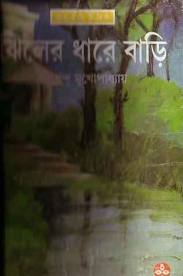jhiler dhAre bARi
sirshendu mukhopAdhyAy
mukhopAdhyAy, sirshendu [shIrShendu];
jhiler dhAre bARi ঝিলের ধারে বাড়ি
Ananda publishers, 1988/2010, 123 pages
ISBN 8170668301 9788170668305
topics: | fiction | bengali | children
shIrShendu mukhopAdhyAy spins another ad-bhUt (ghost mystery) yarn with a gang of dacoits in rural bengal - and a ghost to help the protagonist - though the child characters' concerns (such as exams and low math scores) do not take center-stage as in his classic gosAibAgAner bhUt.
The colourful characters are drawn with a sure touch, and are sure to delight generations of children. Like young readers everywhere, they are drawn more to the mystery and not overly concerned about the authenticity of the story-line. The story unfolds in the old village of keTerhAT, an area "not far from the Bangladesh border" (hence a bit remote from the metropolis). The village was well-known in medieval and British times as the haven for several ferocious dacoit gangs. The plot involves the elderly Sadashib and the middle-aged Nabin, descendants from two opposed dacoit clans, who are now friends, though sadAshib is well-off and nabIn is bankrupt and may soon have to sell his broken-down house.
There are mysteries plenty in the village, including a legendary temple deep below a lake, and a haunted house on the edge of the dark "bandit lagoon" (DAkAte Jhil, ডাকাতে ঝিল), which rings out with the song and laughter of ghosts every night - but, as the elderly caretaker siddhinAth tells his pal sripati, the mudi-shop owner:
siddhinAth crumples his face and says, "these ghosts are so utterly disgusting, i tell you. normally they'll be at their ghastly song and dance every night - but the moment these city folks get there, not a whisper from the scaredy-cats!!" sripati thinks a while and says: "these are village ghosts, you know - may be they don't have the guts to scare those city honchos." - p.23 Another mystery in the village is the impenetrable steel door in the basement of nabIn's house, which has refused to budge for generations. No one knows what might lie in the pAtAlghar on other side. Other hints of a long-lost dacoit treasure abound, as do leThels (martial lAThi-wielding professionals), old women's vision of hell, concoctions of "five bitters" (পঞ্চতিক্ত), and other stories from the bengali heartland. An interesting aside is a reference to the DAkAte kAlIbARI (ডাকাত কালীবাড়ি) - the kAlI temple of dacoits, which used to be the site of human sacrifice (নরবলি) in ancient times. This was particularly interesting since just two days back we visited Singur, which is known for its ancient DAkAT kAlibARi. Sadashib's grandchildren, Anu and Bilu, both of whom are studying at "famous English schools in Kolkata", visit him regularly. Meanwhile, a group of three entomologists suddenly appear and rent the ruins of an ancient house by the jungle's edge. That very weekend, Anu and Bilu encounter lights in the jungle, and several episodes of near-murder follow in quick succession. Despite the enid-blyton-esque plot, the background and characters are far more intimately portrayed, and the stories of the bengal countryside makes it a much more compelling read. I have been away from Bangla children's literature for several decades, and had only sukumAr rAy, shibrAm, satyajit, and an occasional chnAder pAhAR by bibhUtibhUShaN to feed our souls as children. It is a pleasure today to find writers of the caliber of Shirshendu writing for kids. Alas, the kids, like the two child protagonists of this story, are invariably going to English-medium schools, and increasingly take pride in not reading any bAnglA at all. Despite this decimated readership, the fact that kids literary magazines (e.g. AnandamelA) continue to thrive, seems to point to a continuing readership for Bangla, though perhaps not among the middle class. The rage for Enid Blyton and Hardy Boys is all the more tragic, given the undoubtedly superior quality of Bangla literateurs like shIrShendu. Among the unexplained aspects of the story is why the entomologists initially talk of their research as "not only highly secret but even dangerous", or why they try to get rid of the caretaker who normally would have been their primary ally in the new environs... A superb yarn. Un-putdownable.
Excerpts
winter morning. sitting in the sun on his east-side verandah, sadAshib-bAbu was sipping five types of bitter juice made from various leaves. this was pancha-tikta, or the five bitters. very wholesome. on the cane table in front of him, three of yesterday's papers, a small almanac, a diary and a pen. today was gun-cleaning day. on a table to the side, bachan had arranged three heavy rifles, gun oil, spokes and rags. after finishing the juice, sadAshib-bAbu would be glancing through the papers. then he would look up today in the almanac, carefully scanning the transit of the stars for signs. he would look over the diary jottings of last night - maybe edit them a tad. only then would he start cleaning the guns. there were different chores for each day. some day it was cleaning the guns, some day winding up the eleven antique clocks, some day dusting one shelf of the antique-room, some days writing letters, and so on. শোনা যায়, তার পূর্বপুরুষরা ডাকাত ছিলেন। ডাকাতি করে ধনসঞ্চয়ের পর জমিদারি কিনে ব্রিটিশ আমলে 'রাজা' উপাধি পেয়েছিলেন। এ বাড়িতে আগে কালীপূজোয় নরবলি হত। it was said that sadAshib-bAbus ancestors were dacoits. with the wealth they looted, they bought a zamindari from the british, and were given the title of "rAjA". in olden times, on kAlipUja in this house, there used to be narabali - human sacrifice.
amitabha mukerjee (mukerjee [at-symbol] gmail) 2012 May 03
